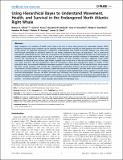Files in this item
Using hierarchical bayes to understand movement, health, and survival in the endangered North Atlantic right whale
Item metadata
| dc.contributor.author | Schick, Robert Schilling | |
| dc.contributor.author | Kraus, Scott D. | |
| dc.contributor.author | Rolland, Rosalind M. | |
| dc.contributor.author | Knowlton, Amy R. | |
| dc.contributor.author | Hamilton, Philip K. | |
| dc.contributor.author | Pettis, Heather M. | |
| dc.contributor.author | Kenney, Robert D. | |
| dc.contributor.author | Clark, James S. | |
| dc.date.accessioned | 2013-07-23T10:01:01Z | |
| dc.date.available | 2013-07-23T10:01:01Z | |
| dc.date.issued | 2013-06 | |
| dc.identifier | 60298873 | |
| dc.identifier | 7ca3a3f4-3fd1-4f36-b633-8f4b6ab28b96 | |
| dc.identifier | 84878800079 | |
| dc.identifier.citation | Schick , R S , Kraus , S D , Rolland , R M , Knowlton , A R , Hamilton , P K , Pettis , H M , Kenney , R D & Clark , J S 2013 , ' Using hierarchical bayes to understand movement, health, and survival in the endangered North Atlantic right whale ' , PLoS One , vol. 8 , no. 6 , e64166 . https://doi.org/10.1371/journal.pone.0064166 | en |
| dc.identifier.issn | 1932-6203 | |
| dc.identifier.uri | https://hdl.handle.net/10023/3860 | |
| dc.description | This article was made open access through BIS OA funding. | en |
| dc.description.abstract | Body condition is an indicator of health, and it plays a key role in many vital processes for mammalian species. While evidence of individual body condition can be obtained, these observations provide just brief glimpses into the health state of the animal. An analytical framework is needed for understanding how health of animals changes over space and time.Through knowledge of individual health we can better understand the status of populations. This is particularly important in endangered species, where the consequences of disruption of critical biological functions can push groups of animals rapidly toward extinction. Here we built a state-space model that provides estimates of movement, health, and survival. We assimilated 30+ years of photographic evidence of body condition and three additional visual health parameters in individual North Atlantic right whales, together with survey data, to infer the true health status as it changes over space and time. We also included the effect of reproductive status and entanglement status on health. At the population level, we estimated differential movement patterns in males and females. At the individual level, we estimated the likely animal locations each month. We estimated the relationship between observed and latent health status. Observations of body condition, skin condition, cyamid infestation on the blowholes, and rake marks all provided measures of the true underlying health. The resulting time series of individual health highlight both normal variations in health status and how anthropogenic stressors can affect the health and, ultimately, the survival of individuals. This modeling approach provides information for monitoring of health in right whales, as well as a framework for integrating observational data at the level of individuals up through the health status of the population. This framework can be broadly applied to a variety of systems – terrestrial and marine – where sporadic observations of individuals exist. | |
| dc.format.extent | 14 | |
| dc.format.extent | 1577952 | |
| dc.language.iso | eng | |
| dc.relation.ispartof | PLoS One | en |
| dc.subject | Body condition | en |
| dc.subject | Health indicator | en |
| dc.subject | Mammals | en |
| dc.subject | Health change | en |
| dc.subject | Population status | en |
| dc.subject | Endangered species | en |
| dc.subject | State-space model | en |
| dc.subject | North Atlantic right whales | en |
| dc.subject | Anthropogenic stressors | en |
| dc.subject | QH301 Biology | en |
| dc.subject | SDG 14 - Life Below Water | en |
| dc.subject | SDG 15 - Life on Land | en |
| dc.subject.lcc | QH301 | en |
| dc.title | Using hierarchical bayes to understand movement, health, and survival in the endangered North Atlantic right whale | en |
| dc.type | Journal article | en |
| dc.contributor.sponsor | Office of Naval Research | en |
| dc.contributor.institution | University of St Andrews. School of Mathematics and Statistics | en |
| dc.contributor.institution | University of St Andrews. Centre for Research into Ecological & Environmental Modelling | en |
| dc.identifier.doi | 10.1371/journal.pone.0064166 | |
| dc.description.status | Peer reviewed | en |
| dc.identifier.grantnumber | N00014-12-1-0286 | en |
This item appears in the following Collection(s)
Items in the St Andrews Research Repository are protected by copyright, with all rights reserved, unless otherwise indicated.

